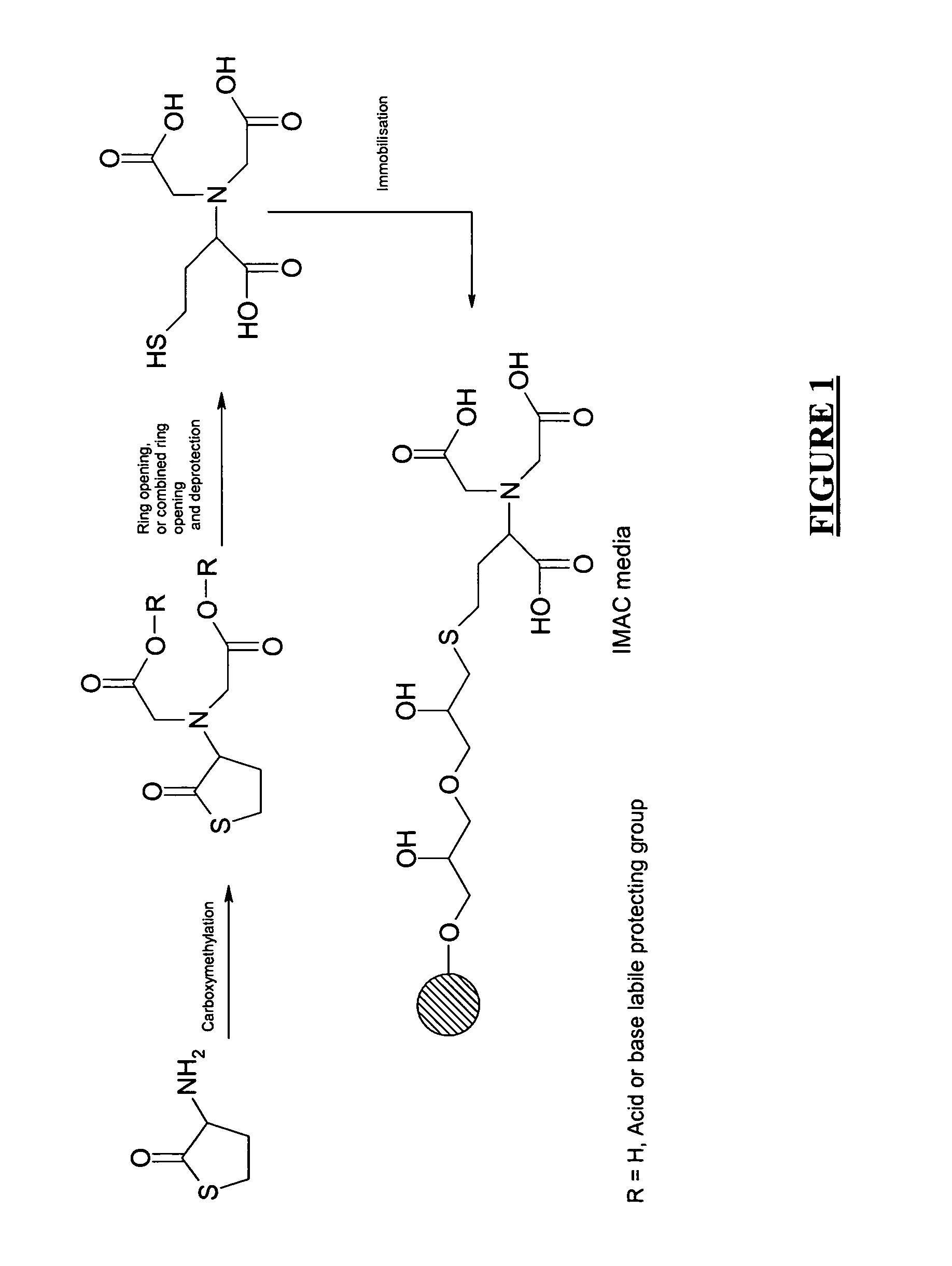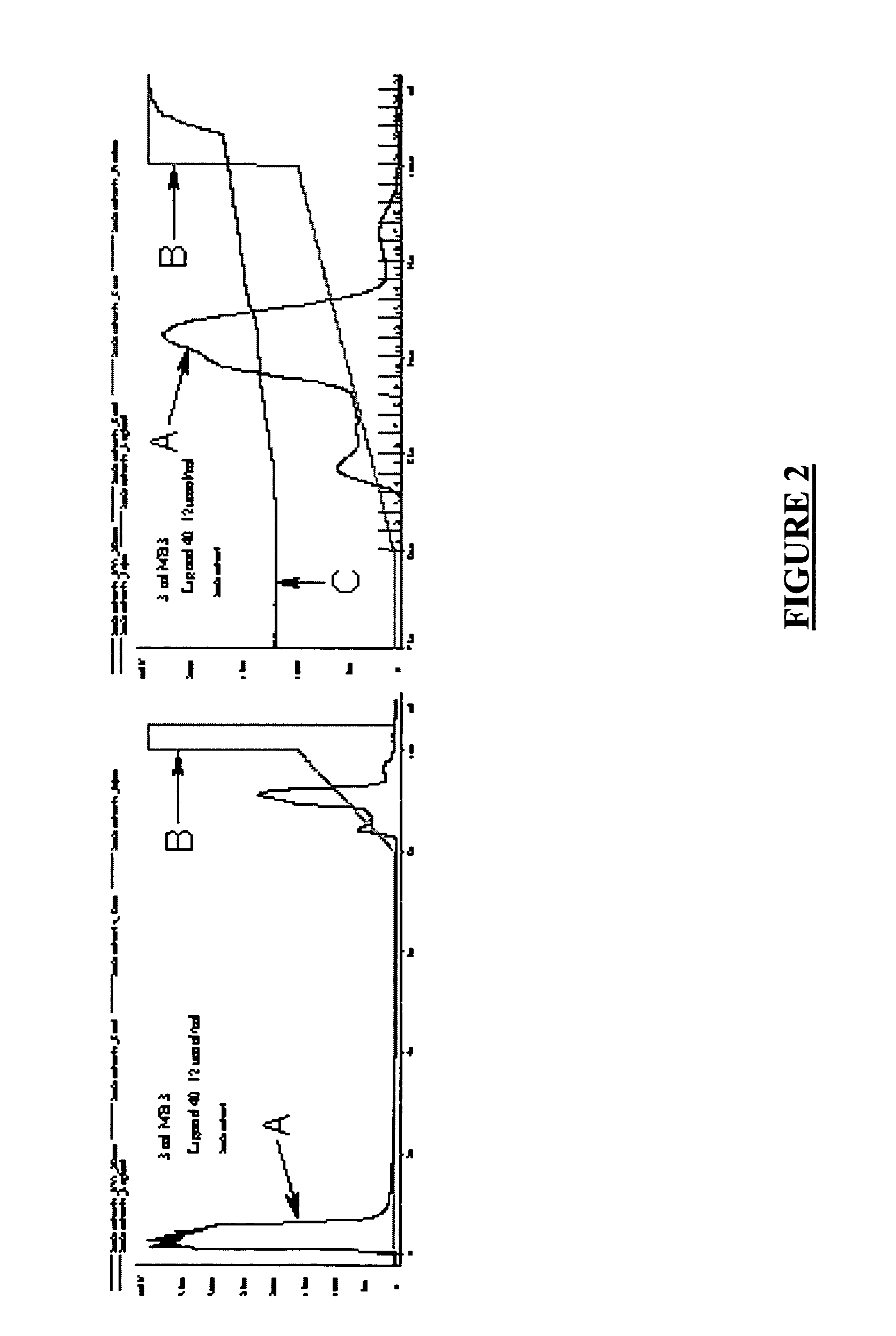Method of generating metal chelating affinity ligands
a metal chelating affinity and ligand technology, applied in the direction of metal/metal-oxide/metal-hydroxide catalysts, chemical/physical processes, peptides, etc., can solve the problems of time-consuming and hence costly methods, undefined product rest products, and low efficiency of alkylation chemistry, etc., to achieve high yield, easy to obtain
- Summary
- Abstract
- Description
- Claims
- Application Information
AI Technical Summary
Benefits of technology
Problems solved by technology
Method used
Image
Examples
example 1
Carboxymethylation of Scaffold to Provide N,N-bis(ethyl-carboxymethyl ester)±homocysteine thiolactone
[0076]In a dry 250 mL round-bottomed flask, the D / L homocysteine thiolactone (4.5 g, 29.22 mmol) was dissolved in 100 mL DMF. To this was added bromo-acetic acid ethyl ester (9.76 g, 58.44 mmol, 6.48 mL), KI (4.850 g, 29.22 mmol) and NaHCO3 (14.727 g, 175 mmol). The reaction mixture was stirred at ambient temperature. The reaction was followed by TLC (toluene:ethyl acetate 3:1) and LC-MS data. The reaction was completed after 3.5 h.
[0077]The desired product has a Rf=0.35 (toluene:ethyl acetate 3:1). The solvent was evaporated, the resulting solid redissolved in CHCl3, extracted with H2O×2. The organic phase was finally dried over Na2SO4, filtered and evaporated. The product was purified on flash column chromatography (toluene:ethyl acetate 3:1).
[0078]Yield: 7.636 g (26.422 mmol), 90%. 1H-NMR: δ 1.52 (t, 6H, CH3—CH2—O—), δ 2.05–2.56 (m, 2H, —S—CH2—CH2—CH—C═O), δ 3.25 (m, 2H, —S—CH2—CH...
example 2
Hydrolysis to Provide N,N-bis(carboxymethyl)±homocysteine and Stability Test
[0079]N,N-bis(ethyl carboxymethyl ester)+ / −homocysteine thiolactone (50 mg, 0.173 mmol) prepared as described in example 1 above, was dissolved in 1 mL 1M NaOH. In a 100 mL round-bottomed flask. The reaction mixture was stirred at ambient temperature for 100 minutes. The reaction was followed to completion until no starting material was visible according to LC-MS.
[0080]Stability test: After complete hydrolysis, the above reaction mixture was diluted to 5 mL with H2O. The pH was adjusted to 12.5 and the reaction mixture was heated at 50° C. with stirring. A 50 μL sample was withdrawn from the mixture with 1 h intervals for four hours. Each 50 μL sample was then mixed with 1 mL MeOH for the LC-MS analysis. After this step, the reaction mixture was allowed to stand overnight and finally a 50 μL sample was withdrawn for the LC-MS analysis as described above. No decomposition was observed during the time of the e...
example 3
Coupling of the Product Obtained from Example 2 to Allylated Agarose Using AGE
[0083]10 ml Sepharose™ HP-allyl (Amersham Biosciences, Uppsala, Sweden) (44 μmol / ml gel) was stirred in 20 ml distilled water with 1 g NaOAc. Br2 aq. saturated was added until that a persisting yellow colour is formed. Sodium formiate was then added until the yellow colour has disappeared. The gel was then washed with distilled water. N,N-bis(ethyl carboxymethyl ester)+ / −homocysteine thiolactone (102 mg) was stirred in 2 ml 1M NaOH at room temperature for 2 hours. 5 ml distilled water and 3 ml 1M NaHCO3 was added, and the pH was adjusted to 11.0 with 2M NaOH.
[0084]The ligand solution was then added to the drained gel in a vial, which was capped.
[0085]The vial was shaken at 50° C. for 16 h, then the gel was washed with distilled water on a glass filter funnel.
PUM
 Login to View More
Login to View More Abstract
Description
Claims
Application Information
 Login to View More
Login to View More - R&D
- Intellectual Property
- Life Sciences
- Materials
- Tech Scout
- Unparalleled Data Quality
- Higher Quality Content
- 60% Fewer Hallucinations
Browse by: Latest US Patents, China's latest patents, Technical Efficacy Thesaurus, Application Domain, Technology Topic, Popular Technical Reports.
© 2025 PatSnap. All rights reserved.Legal|Privacy policy|Modern Slavery Act Transparency Statement|Sitemap|About US| Contact US: help@patsnap.com



